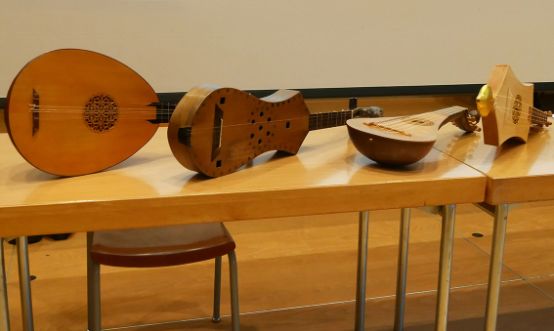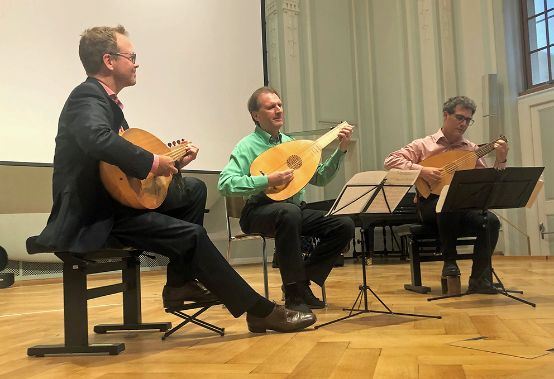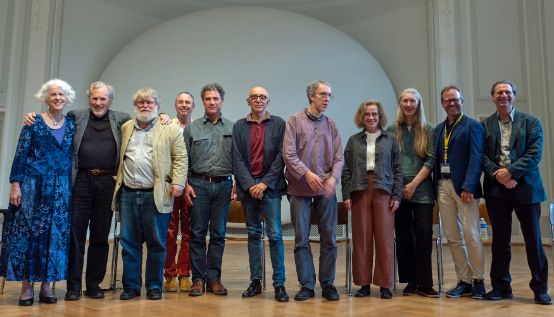Basel Lute Days
The "Basel Lute Days", a collaboration between the Deutsche Lautengesellschaft and the Schola Cantorum Basiliensis, took place on the campus of the Musik-Akademie from September 14 to 18, 2022. An international audience of experts attended conferences of the International Musicological Society Study Group "Tablature in Western Music", the 2nd International Conference on Lute Study in Higher Education and the International Lute Festival of the German Lute Society.

On September 14, John Griffiths opened a meeting of the International Musicological Society Study Group "Tablature in Western Music" at the Basel Lute Days. Irina Döring then kicked things off with a discussion of not clearly interpretable spellings in the earliest surviving lute tablatures. In particular, she discussed the question of how certain sounds should be played together - arpeggiated, struck simultaneously, plucked with fingers or with a plectrum. Maria Christina Cleary's lecture took up a similar topic, but with reference to Spanish harp tablatures of the 16th century, in which, according to Cleary, intuitive playing gestures can also be found. Grzegorz Joachimiak then drew attention to the problem that some lute works have only survived in 20th century transcriptions, while the original sources were lost due to the war. He presented one example and discussed the circumstances of the transcription's creation. Hector Sequera then presented his observations on Robert Ballard's lute books. Sequera put forward the thesis that, in view of the profound changes in music at the beginning of the 17th century, the tablatures were virtually fossils and did not reflect the stylistic changes. However, an appropriate instrumental interpretation must take this into account. Sara Salloum also explored a practical performance question, dealing with unusually placed ornaments in the Margaret Board Lute Book was busy. She was able to convincingly demonstrate that the ornaments are related to the main notes of the mode of a piece. In his lecture, David Dolata compared the two editions of Vincenzo Galilei's teaching dialog Il Fronimowhich were published in 1568 and 1584 respectively. The later edition is extended by around 30 pages and deals with topics such as tunings, tastini, lutes with more than six choirs and reflects Galileo's intensive study of ancient music theory.
Open questions for new editions
Finally, Victor Coelho presented a major new project for the lute world: the new edition of the Collected works of Francesco da Milano. The first complete edition, which was published in 1970 under the editorship of Arthur J. Ness, is naturally no longer up to date and justifies a new edition. Coelho gave a vivid account of the numerous problems that the new editors would now have to solve: Which pieces are really by Francesco, which are only attributed to him? How trustworthy are the individual sources? How do Italian sources differ from non-Italian sources? Which source should be given preference in the case of multiple traditions? And so on. Joshua Rifkin addressed very similar problems and questions in his lecture, albeit with reference to Josquin des Prez. There are also many uncertainties regarding the transmission of Josquin's works, and Rifkin noted that many musicologists tend to attribute pieces to famous composers such as Josquin, even when the sources are poor. In fact, however, Josquin's surviving oeuvre is probably much smaller than previously assumed.
(Ya'qub El-Khaled)
Early music and modern technology
Two items on the program linked "old" music to current computer technology: Kateryna Schöning presented her new project "E-LAUTE: Electronic Linked, Annotated, and Unified Tablature Edition", which is funded by the Austrian Science Fund (FWF), the Swiss National Science Foundation (SNF) and the German Research Foundation (DFG). This is nothing less than a digital, freely accessible edition of the lute tablatures of the German-speaking world between 1450 and 1550, which will not only contain scans of the facsimiles and transcriptions in all standard tablature systems, but also practical performance information, audio recordings and additional texts. Schöning also gave an overview of her ongoing project "Tablatures and Humanism - Semantics of Maxims and Music in 16th Century Lute Tablatures" (funded by the FWF).
At the roundtable on "New Technologies and Practices for Tablature Encoding", Laurent Pugin (Répertoire International des Sources Musicales RISM), David Lewis (University of Oxford), Reinier de Valk and Tim Crawford (Goldsmith University of London) examined various aspects, opportunities and possibilities of digitization in the context of lute tablatures.
(Nicole Merkel)

Lute teachers at the SCB/FHNW: from left Marc Lewon, Peter Croton, Julian Behr
Photo: Gregor von Dungen
Lute instruments at the university
The second event of the Basel Lute Days was the 2nd International Conference on Lute Study in Higher Education on September 15 and 16. At this conference, which focused on the rather limited field of higher education studies of lute instruments, no quick administrative solutions to the many pedagogical problems or direct influence on higher education policy structures could be expected. Rather, the lutenists, lute teachers, lute pedagogues and enthusiasts who came together from all over the world were interested in exchanging thoughts and ideas, making contacts and connecting the past of the lute with its future.
The first conference of this kind was held at Bremen University of the Arts in September 2019 and was a great success. Once again, the line-up of speakers was international and prominent and the audience was very interested. And once again, the lectures covered a wide range of topics relating to the higher education of young lutenists. After welcoming remarks by Stephan Schmidt, Director of the University of Music of the University of Applied Sciences Northwestern Switzerland (FHNW)Martin Kirnbauer, Head of Research, Head of the Early Music Theory program, Schola Cantorum Basiliensis (SCB) and Peter Croton (lecturer for lute SCB, president of the German Lute Society and organizer of the conference) Kelly Landerkin (SCB) gave in her opening speech Teaching Teachers: Early Music Pedagogy in the 21st century an interesting overview of the development of teaching methods over the past centuries and their impact on modern teaching.
University teaching historically ...
The following lectures dealt partly with topics directly related to university teaching: Marc Lewon, professor of medieval and early modern lute instruments at the SCB, looked back at the development of his subject under his predecessors Thomas Binkley, Ken Zuckerman and Crawford Young, and at the early attempts to reconstruct medieval plectrum lutes. He answered his questions "What do I do, why do I do it and what is expected of me?" with an overview of the relevant developments in music-historical research on repertoire and playing technique over the past decades. The knowledgeable audience looked with particular interest at the instruments he had brought with him, such as the citole, cetre and giterne.
... in Great Britain ...
Lynda Sayce, lutenist and professor of theorbo at the University of Birmingham, spoke about the many challenges of her work within the university structures at Bachelor's and Master's level in the UK. Both heterogeneous prior knowledge and access to study, expensive instruments and repertoire posed considerable problems for the students. The audience spontaneously took up Sayce's idea of compiling an anthology of teaching material for theorbo on an international basis.
... and socially critical
In her lecture, British lutenist Elizabeth Kenny, Professor of Lute at the Royal Academy of Music in London, addressed the problems of early modern song texts in performances of early music in the era of the cancel culture and me-too movements. How should an ensemble deal with the changed evaluation of the image of women, for example: contextualize, change, avoid? The past is like a foreign country where many things are done differently, but there are also pieces of music that can act as a bridge between the centuries.
Basso continuo, Improvisation
Julian Behr, professor of lute at the SCB, presented his thoughts on basso continuo practice using the example of the so-called Carlo G manuscript for chitarrone from the early 17th century. Bass accompaniment is an important part of the training and later ensemble activity of lutenists. Behr interpreted the written-out bass parts in versions for organ and chitarrone as transitions between figured bass and intavolations.
The English lutenist Nigel North also passed on his wealth of experience: with the aid of his lute, he taught the basics and typical patterns of the melodic ornamentation important for improvisation and interpretation in early modern, especially English lute music, which has rarely been handed down in original sources.
Study content and physiology
Other lectures also offered specific instructions for studying the lute. For example, Peter Croton, who teaches lute and basso continuo at the Schola Cantorum, spoke about training for the baroque lute in the 21st century, illustrated with examples from his textbook. Sophisticated concerts require a great deal of theoretical knowledge based on historical sources. However, Croton felt that teaching lute instruments also needed to convey an understanding of rhetorical elements, phrasing, sound concepts, an anatomically sound posture when playing and efficient practicing techniques.
Paul O'Dette dedicated his lively presentation to the latter topic. The "Art of Practicing" consists of targeted problem solving. Enriched by numerous practical examples and tips, he was able to convince the audience that thoughtful and motivated practicing is not only indispensable and productive for beginners.
The lutenist and physiotherapist Jacob Heringman dedicated his lecture to another fundamental topic: he spoke about the great benefits of the ergonomically oriented technique developed by F. M. Alexander for lutenists too. It was clear from feedback from the audience that postural problems and chronic complaints are not uncommon and require early recognition and correction of movement sequences.
Study of sources
Research into old music prints and manuscripts and the study of original sources, it was emphasized once again, must be taught to students of early music as indispensable skills. These aspects were highlighted in the lectures by Andrea Damiani, Paul Breier and Catherine Liddell.
Andrea Damiani, professor of lute in Rome, gave a lecture on pieces of music by various composers from the collection of 17th century lute manuscripts from the Castelbarco Albani archive in Pesaro. The examples, attributed to Orazio and Malatesta Albani, presented by Damiani in their musical structure and later performed for the first time in a concert on the lute, were impressive in their complexity and beauty.
Paul Breier (Milan) analyzed the lute book by Vincenco Capirola, one of the most beautiful, colourfully illustrated and musically richest manuscripts of the early 16th century, with regard to its publication history by Capirola's pupil Vidal. Both Vidal's self-portrayal and the question of authorization of the manuscript by Capirola were discussed.
The lutenist and president of the Lute Society of America Catherine Liddell recorded the musical pieces for lute with allegorical titles in Denis Gaultier's Rhétorique des Dieux from the middle of the 17th century by presenting her thoughts on the connection between the titles and the musical structure of lute music.
Concerts and discussions
All speakers (many of them graduates of the SCB) presented themselves in three well-attended concerts with a music-historically and stylistically wide-ranging repertoire on different lute instruments; some referred to their lecture topics.
Two round-table discussions also provided important food for thought: The extremely heterogeneous experiences and opportunities when studying the lute at European teaching institutions became clear in the discussion between the eight students and young graduates from six countries on the topic of "Studying the Lute from the Student's Perspective". The acquisition of knowledge about continuo playing was considered particularly important. Some were considering a future career in teaching. The concluding discussion round of the teachers on the progress and perspectives of university teaching for lute summarized suggestions from the past days and thoughts on the modern teacher-student relationship. Students, teachers, performers and non-professional lutenists alike were able to take away a wealth of new insights and suggestions for the benefit of the lute world from this very well-organized event.
(Sigrid Wirth)

Speakers at the conference : from left Catherine Liddell, Nigel North, Paul O'Dette, John Griffiths, Julian Behr, Andrea Damiani, Jacob Heringman, Elizabeth Kenny, Lydna Sayce, Marc Lewon, Peter Croton
Photo: Polivios








